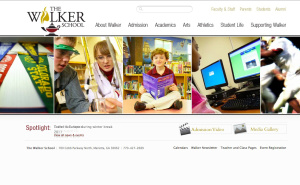First Impressions

New district, same questions.
As America heads back to school for the 2010-2011 school year, teachers are sprucing up their websites with links, rules, schedules, supply lists, do’s and don’ts, and the accoutrement that their administrators deem as necessary information. In looking around at so many school websites, individual teacher pages, and other special interest pages that schools have, I see such a disparity in how they are designed. Were there any serious questions given to functionality? Was the community asked for its input? Did parents have a chance to give feedback on what they wanted to see on their child’s teacher in regards to their website?
My district is moving to a new host for its website, and it happens to be one I am familiar with from a previous district. In looking around the newly designed site today, I remember having hours of conversations with both teachers and administrators about what the purpose of the website was going to be? They were concerned with what was on it and I was more concerned with what was not on it. This is our brand, for lack of a better term; it’s our masthead. From this place online, we invite visitors into our online space. It had better do what we intend it to do.
From the teacher’s perspective, you have choices to make right now. What do you want this space to be? Do you know what your students’ parents want it to be? Are you using it as a means to send home weekly, bi-weekly or monthly information? Are you using it as a place where students can download forms, notes, or other business items? Is your daily homework listed there?
Whatever decisions you make now will have ramifications on you for the next few months. For example, if you feel that this year is going to be the year that you update the website with weekly plans for students and parents, and you go like mad for two months, and then November hits and you miss a week or two. What happens then? What if your plan is killing your time? If you work in an elementary school, the time you have to update a website will quickly be usurped by myriad other responsibilities, and the precious prep time you have may not be reserved for website updating. By putting this out there to your students and parents, you are sending a message that this is how I run things. When you change that midstream, that message is changed, and you stand to lose credibility.
What I’ve always told the teachers I have worked with is this: decide now what you want this to be, and make sure it matches who you are. If you are not someone who plans on updating this daily or weekly, don’t design a page that has elements that call for frequent updating. Include basic elements of your bio, your contact information, and your daily and weekly teaching schedule so parents can see when the best times to reach you are. If, however, you have grand designs of using this as a hub, and the platform your school or district uses is friendly enough, go for it. Just make sure you plan time in your week for updates.
If, however, you were like me, you may quickly outgrow the capabilities of what the platform offered you. That’s OK too. What I did was to link everything from the school page to the places where students and parents could find where we were working. I also included explanations of why that was the best place for us to work (wikis for collaboration, blogs for reflection, etc.)
Tools and ideas to transform education. Sign up below.
In looking for some examples, these were suggested by a few people from within my network (Thanks to Megan and Bill).


What can we infer about these schools from these pages? What do you look for in a school or teacher website? What is required of you by your administration or community?
Cross-posted at Chalkdust101.
